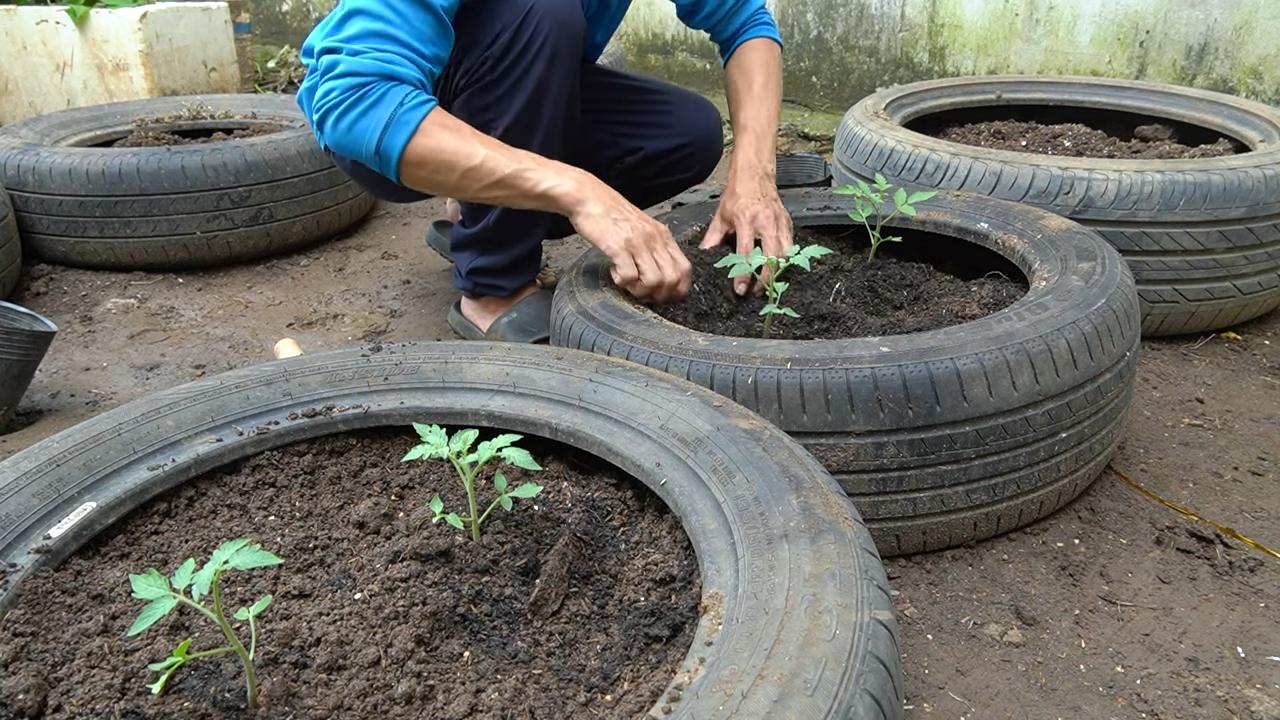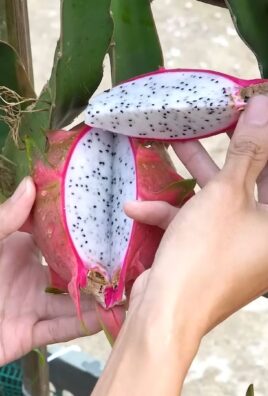Grow tomatoes at home, even if you think you have a black thumb! Let’s face it, there’s nothing quite like biting into a sun-warmed, juicy tomato that you’ve nurtured from a tiny seed. Forget those bland, store-bought imitations – we’re talking about flavor explosions right from your own backyard (or balcony!).
For centuries, cultivating tomatoes has been a cherished tradition. Originating in South America, these vibrant fruits have journeyed across continents, becoming a staple in cuisines worldwide. From Italian pasta sauces to refreshing summer salads, the tomato’s versatility is undeniable. But did you know that growing your own isn’t just about taste? It’s about connecting with nature, reducing your carbon footprint, and enjoying the satisfaction of harvesting something you’ve created.
But let’s be real, the idea of growing your own food can feel intimidating. Where do you even start? What if you don’t have a huge garden? That’s where these simple, yet effective, DIY tricks and hacks come in! I’m going to share some of my favorite secrets to help you grow tomatoes at home successfully, regardless of your space or experience level. Whether you’re a seasoned gardener or a complete newbie, these tips will empower you to enjoy a bountiful tomato harvest. Get ready to roll up your sleeves and transform your space into a tomato-growing paradise!

Tomatenanbau zu Hause: Dein umfassender DIY-Leitfaden
Hallo Gartenfreunde! Ich freue mich riesig, euch heute in die wunderbare Welt des Tomatenanbaus zu Hause einzuführen. Es gibt kaum etwas Befriedigenderes, als eine saftige, sonnengereifte Tomate aus dem eigenen Garten zu ernten. Und das Beste daran? Es ist gar nicht so schwer, wie man vielleicht denkt! Egal, ob du einen großen Garten, einen kleinen Balkon oder nur ein sonniges Fensterbrett hast, mit diesem Leitfaden kannst du deine eigenen Tomaten ziehen. Los geht’s!
Was du für den Tomatenanbau brauchst
Bevor wir loslegen, lass uns sicherstellen, dass wir alles Nötige zusammen haben. Hier ist eine Liste der wichtigsten Dinge:
* Tomatensamen oder Jungpflanzen: Du kannst entweder mit Samen beginnen oder Jungpflanzen kaufen. Samen sind günstiger, aber Jungpflanzen sparen Zeit und Mühe.
* Anzuchterde: Spezielle Anzuchterde ist nährstoffarm und locker, ideal für die Keimung von Samen.
* Töpfe oder Anzuchtschalen: Für die Anzucht der Samen oder zum Umtopfen der Jungpflanzen.
* Größere Töpfe oder ein Beet: Für die ausgewachsenen Tomatenpflanzen. Die Größe hängt von der Tomatensorte ab.
* Tomatenerde: Nährstoffreiche Erde, die speziell für Tomaten entwickelt wurde.
* Dünger: Flüssigdünger oder Langzeitdünger für Tomaten.
* Pflanzstäbe oder Rankgitter: Um die Tomatenpflanzen zu stützen, besonders bei hochwachsenden Sorten.
* Gießkanne oder Gartenschlauch: Zum Bewässern der Pflanzen.
* Gartenschere: Zum Ausgeizen der Tomatenpflanzen.
* (Optional) Gewächshaus oder Folientunnel: Für eine frühere Ernte und Schutz vor schlechtem Wetter.
Aussaat der Tomatensamen (Schritt-für-Schritt)
Wenn du mit Samen beginnen möchtest, ist das hier dein Fahrplan:
1. Vorbereitung der Anzuchtschalen: Fülle die Anzuchtschalen oder kleinen Töpfe mit Anzuchterde. Drücke die Erde leicht an.
2. Aussaat der Samen: Lege 2-3 Samen pro Topf oder Zelle. Bedecke die Samen mit einer dünnen Schicht Erde (ca. 0,5 cm).
3. Bewässerung: Befeuchte die Erde vorsichtig mit einer Sprühflasche. Die Erde sollte feucht, aber nicht nass sein.
4. Standort: Stelle die Anzuchtschalen an einen warmen und hellen Ort. Eine Temperatur von 20-25°C ist ideal. Ein Mini-Gewächshaus oder eine durchsichtige Plastikabdeckung kann helfen, die Feuchtigkeit zu halten.
5. Geduld: Die Samen keimen in der Regel innerhalb von 7-14 Tagen. Halte die Erde während dieser Zeit feucht.
6. Pikieren: Sobald die Sämlinge ihre ersten richtigen Blätter (nach den Keimblättern) entwickelt haben, kannst du sie pikieren. Das bedeutet, du setzt jeden Sämling einzeln in einen größeren Topf. Gehe dabei vorsichtig vor, um die Wurzeln nicht zu beschädigen.
Umtopfen der Jungpflanzen
Sobald deine Jungpflanzen groß genug sind (ca. 15-20 cm hoch), ist es Zeit, sie in größere Töpfe oder ins Beet umzupflanzen.
1. Vorbereitung der Töpfe oder des Beets: Fülle die größeren Töpfe oder das Beet mit Tomatenerde. Achte darauf, dass die Erde locker und gut durchlässig ist.
2. Ausheben der Pflanzlöcher: Hebe Löcher aus, die etwas größer sind als die Wurzelballen der Jungpflanzen.
3. Einsetzen der Pflanzen: Nimm die Jungpflanzen vorsichtig aus ihren Töpfen. Du kannst die Wurzeln leicht aufbrechen, um das Wachstum anzuregen. Setze die Pflanzen in die Löcher und fülle sie mit Erde auf.
4. Bewässerung: Gieße die Pflanzen gründlich an.
5. Stütze: Setze Pflanzstäbe oder Rankgitter neben die Pflanzen, um sie zu stützen.
6. Standort: Wähle einen sonnigen Standort für deine Tomatenpflanzen. Sie brauchen mindestens 6-8 Stunden Sonne pro Tag.
Pflege der Tomatenpflanzen
Die Pflege der Tomatenpflanzen ist entscheidend für eine reiche Ernte. Hier sind einige wichtige Tipps:
* Bewässerung: Gieße die Tomatenpflanzen regelmäßig, besonders während der heißen Sommermonate. Vermeide es, die Blätter zu benetzen, um Pilzkrankheiten vorzubeugen. Gieße am besten morgens, damit die Pflanzen tagsüber abtrocknen können.
* Düngung: Dünge die Tomatenpflanzen regelmäßig mit einem speziellen Tomatendünger. Beginne damit etwa 2-3 Wochen nach dem Umtopfen. Folge den Anweisungen auf der Düngerpackung.
* Ausgeizen: Das Ausgeizen ist ein wichtiger Schritt, um das Wachstum der Tomatenpflanzen zu fördern. Entferne regelmäßig die Seitentriebe, die in den Blattachseln wachsen. Diese Triebe nehmen der Pflanze unnötig Kraft und Energie.
* Stützen: Binde die Tomatenpflanzen regelmäßig an die Pflanzstäbe oder Rankgitter, um sie zu stützen. Das verhindert, dass die Pflanzen umknicken oder die Früchte auf dem Boden liegen.
* Schutz vor Krankheiten und Schädlingen: Achte auf Anzeichen von Krankheiten oder Schädlingen. Bei Bedarf kannst du biologische Schädlingsbekämpfungsmittel einsetzen. Eine gute Belüftung und das Vermeiden von Staunässe können Pilzkrankheiten vorbeugen.
Sortenwahl: Welche Tomate passt zu dir?
Die Auswahl der richtigen Tomatensorte ist entscheidend für den Erfolg deines Tomatenanbaus. Es gibt unzählige Sorten, die sich in Größe, Form, Farbe, Geschmack und Widerstandsfähigkeit unterscheiden. Hier sind einige beliebte Sorten:
* Cocktailtomaten: Kleine, süße Tomaten, ideal für den Anbau im Topf oder auf dem Balkon. Beliebte Sorten sind ‘Cherry Belle’, ‘Sungold’ oder ‘Ildi’.
* Fleischtomaten: Große, saftige Tomaten mit viel Fruchtfleisch. Ideal für Salate oder zum Füllen. Beliebte Sorten sind ‘Ochsenherz’, ‘Marmande’ oder ‘Black Krim’.
* Eiertomaten: Ovale Tomaten mit festem Fruchtfleisch. Ideal für Saucen oder zum Einlegen. Beliebte Sorten sind ‘Roma’, ‘San Marzano’ oder ‘Andine Cornue’.
* Buschtomaten: Kompakte Tomatenpflanzen, die nicht ausgegeizt werden müssen. Ideal für den Anbau im Topf oder auf dem Balkon. Beliebte Sorten sind ‘Tiny Tim’, ‘Balconi Red’ oder ‘Vilma’.
* Stabtomaten: Hochwachsende Tomatenpflanzen, die ausgegeizt und gestützt werden müssen. Sie bringen in der Regel eine höhere Ernte als Buschtomaten. Beliebte Sorten sind ‘Matina’, ‘Harzfeuer’ oder ‘De Berao’.
Erntezeit: Der Lohn deiner Mühe
Nach all der Arbeit und Geduld ist es endlich soweit: Die Tomaten sind reif und können geerntet werden!
1. Reife erkennen: Reife Tomaten haben eine intensive Farbe und geben auf leichten Druck nach.
2. Ernten: Schneide die Tomaten vorsichtig mit einer Gartenschere ab. Lasse einen kleinen Stielansatz an der Tomate.
3. Lagerung: Lagere die Tomaten an einem kühlen und trockenen Ort. Vermeide es, sie im Kühlschrank zu lagern, da sie sonst an Geschmack verlieren.
Häufige Probleme und Lösungen
Auch beim Tomatenanbau können Probleme auftreten. Hier sind einige häufige Probleme und wie du sie lösen kannst:
* Blütenendfäule: Braune Flecken am Blütenende der Tomaten. Ursache ist meist ein Calciummangel.

Conclusion
So, there you have it! Growing tomatoes at home, even if you’ve never considered yourself a gardener, is not only achievable but incredibly rewarding. We’ve walked through the simple steps, highlighted the key benefits, and hopefully, demystified the process. Forget those bland, store-bought tomatoes that lack that sun-ripened flavor. Imagine biting into a juicy, vibrant tomato, bursting with sweetness, that you nurtured from seed (or seedling!) right in your own backyard, balcony, or even windowsill.
This isn’t just about saving money (although that’s a definite perk!). It’s about connecting with nature, understanding where your food comes from, and experiencing the pure joy of harvesting something you’ve grown yourself. The satisfaction is unparalleled. Plus, you have complete control over what goes into your tomatoes – no harmful pesticides or artificial fertilizers needed!
But the best part? The possibilities are endless! Once you’ve mastered the basics, you can experiment with different varieties. Try growing heirloom tomatoes for their unique flavors and colors, cherry tomatoes for snacking, or Roma tomatoes for making your own delicious sauces. You can even explore companion planting, adding herbs like basil and marigolds to your tomato patch to deter pests and enhance flavor. Consider adding a trellis or cage to support your growing plants, especially for larger varieties.
Don’t be afraid to get your hands dirty and embrace the learning process. There will be challenges along the way – a few pests, perhaps a bit of wilting – but that’s all part of the fun. Each season brings new lessons and opportunities to refine your growing techniques.
We truly believe that everyone can successfully grow tomatoes at home. It’s a simple pleasure that brings so much joy and deliciousness to your table. So, grab some seeds or seedlings, find a sunny spot, and get started! You won’t regret it.
We’re eager to hear about your experiences! Share your tomato-growing journey with us in the comments below. Tell us what varieties you’re growing, what challenges you’ve faced, and what tips you’ve learned along the way. Let’s create a community of home tomato growers, sharing our knowledge and inspiring each other to cultivate the most delicious tomatoes possible. Happy gardening!
Frequently Asked Questions (FAQ)
Q: What is the best time to start growing tomatoes at home?
A: The ideal time to start growing tomatoes depends on your climate. In warmer regions with long growing seasons, you can start seeds indoors 6-8 weeks before the last expected frost. In cooler regions, you might want to start them even earlier. If you’re buying seedlings from a nursery, wait until after the last frost to transplant them outdoors. A good rule of thumb is to wait until the soil temperature consistently reaches at least 60°F (15°C).
Q: What kind of soil is best for growing tomatoes?
A: Tomatoes thrive in well-draining, fertile soil that is rich in organic matter. A slightly acidic soil pH of 6.0 to 6.8 is ideal. Before planting, amend your soil with compost, aged manure, or other organic materials to improve drainage and nutrient content. Avoid heavy clay soils, as they can become waterlogged and hinder root growth. If you’re growing in containers, use a high-quality potting mix specifically formulated for vegetables.
Q: How much sunlight do tomatoes need?
A: Tomatoes are sun-loving plants and require at least 6-8 hours of direct sunlight per day to produce a bountiful harvest. Choose a location in your garden or on your balcony that receives ample sunlight throughout the day. If you’re growing indoors, supplement with grow lights if necessary. Insufficient sunlight can lead to leggy plants, reduced flowering, and smaller, less flavorful tomatoes.
Q: How often should I water my tomato plants?
A: Water your tomato plants deeply and regularly, especially during hot, dry weather. Aim to keep the soil consistently moist but not waterlogged. Water at the base of the plant to avoid wetting the foliage, which can increase the risk of fungal diseases. A good rule of thumb is to water when the top inch of soil feels dry to the touch. Mulching around your tomato plants can help retain moisture and suppress weeds.
Q: What are some common tomato pests and diseases, and how can I prevent them?
A: Tomatoes are susceptible to various pests and diseases, including aphids, tomato hornworms, blossom end rot, and early blight. To prevent problems, practice good garden hygiene, such as removing weeds and debris, and providing adequate spacing between plants for good air circulation. Inspect your plants regularly for signs of pests or diseases and take action promptly. Organic pest control methods, such as insecticidal soap or neem oil, can be effective for controlling aphids and other pests. Blossom end rot is caused by calcium deficiency, which can be prevented by ensuring your soil has adequate calcium and watering consistently.
Q: Do I need to prune my tomato plants?
A: Pruning tomato plants can improve air circulation, reduce disease risk, and encourage fruit production. Determinate tomato varieties (bush tomatoes) generally don’t require much pruning, while indeterminate varieties (vining tomatoes) benefit from regular pruning. Remove suckers (the small shoots that grow between the main stem and branches) to encourage the plant to focus its energy on fruit production. You can also remove yellowing or diseased leaves to improve air circulation.
Q: How do I know when my tomatoes are ripe?
A: The color of a ripe tomato depends on the variety, but generally, tomatoes are ripe when they have reached their mature color and are slightly soft to the touch. Gently squeeze the tomato; it should give slightly but not be mushy. The tomato should also detach easily from the vine. The aroma of a ripe tomato is also a good indicator of ripeness.
Q: Can I grow tomatoes in containers?
A: Yes, you can absolutely grow tomatoes in containers! Choose a large container (at least 10 gallons) with drainage holes. Use a high-quality potting mix and provide adequate sunlight and water. Dwarf or bush tomato varieties are particularly well-suited for container gardening. Be sure to fertilize your container-grown tomatoes regularly, as nutrients can leach out of the soil more quickly in containers.
Q: What are some good companion plants for tomatoes?
A: Companion planting can benefit tomatoes by attracting beneficial insects, repelling pests, and improving soil health. Some good companion plants for tomatoes include basil, marigolds, onions, garlic, carrots, and parsley. Basil is said to improve the flavor of tomatoes and repel tomato hornworms. Marigolds deter nematodes and other soil pests.
Q: How can I save seeds from my tomato plants for next year?
A: Saving seeds from your tomato plants is a great way to preserve your favorite varieties and save money. Choose ripe, healthy tomatoes from disease-free plants. Squeeze the seeds and pulp into a jar and add a little water. Let the mixture ferment for a few days, stirring occasionally. This process helps to remove the gelatinous coating around the seeds. After fermentation, rinse the seeds thoroughly and spread them out on a paper towel to dry completely. Store the dried seeds in an airtight container in a cool, dark place.




Leave a Comment